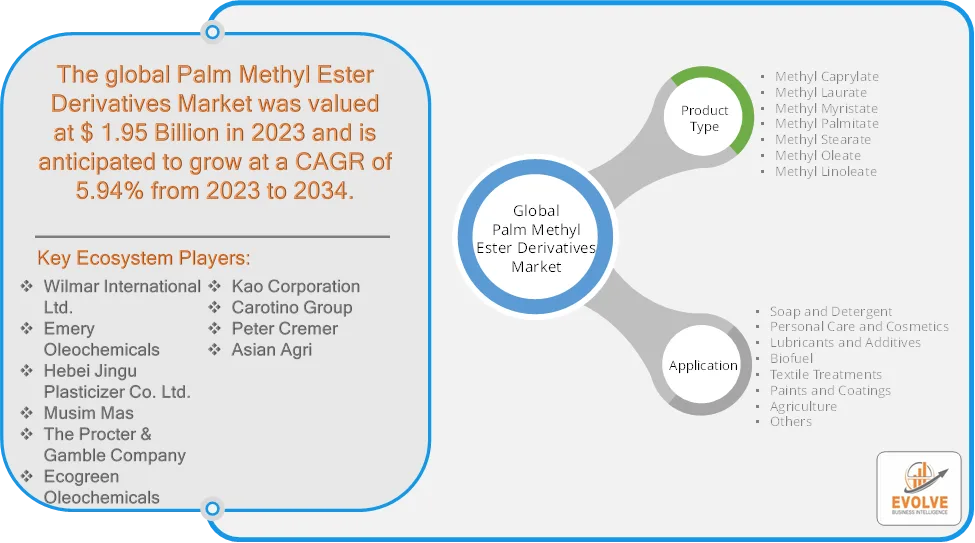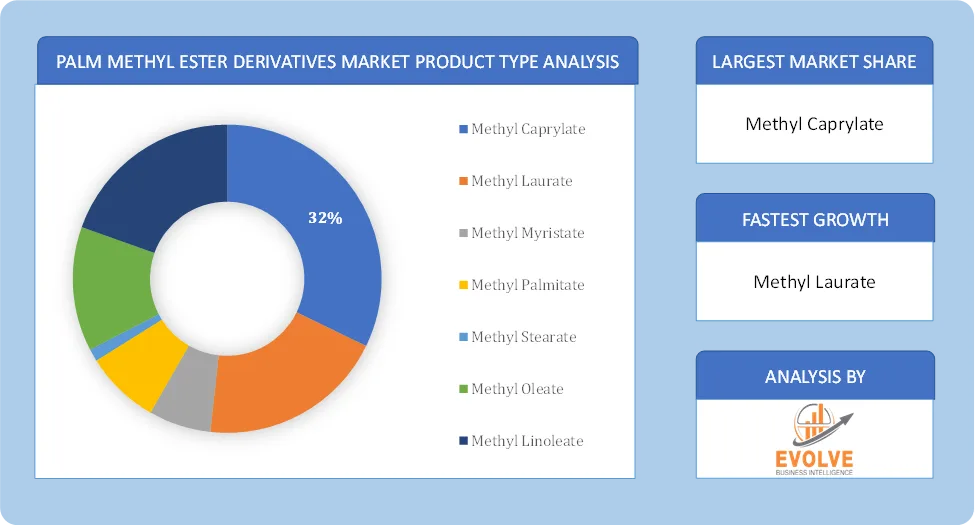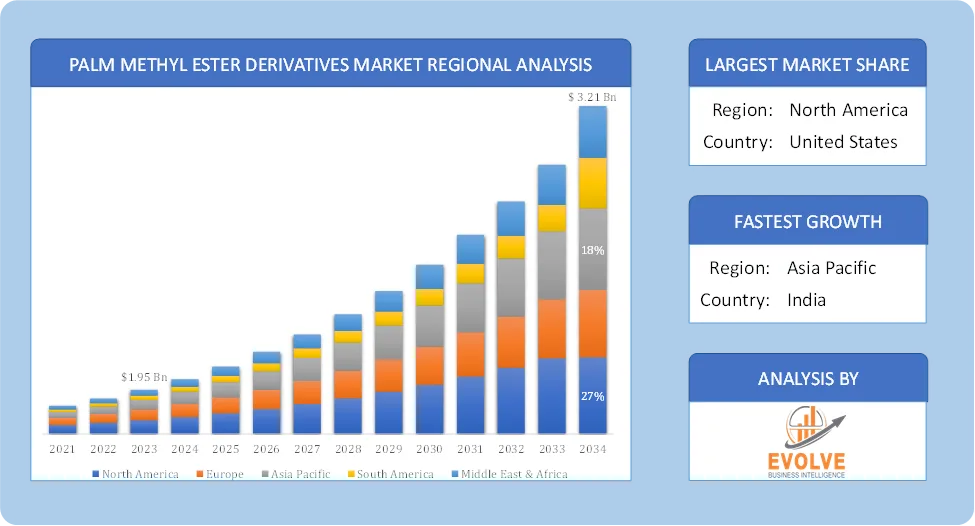Palm Methyl Ester Derivatives Market Analysis and Global Forecast 2023-2033
$1,390.00 – $5,520.00Price range: $1,390.00 through $5,520.00
Palm Methyl Ester Derivatives Market Research Report: Information By Product Type (Methyl Caprylate, Methyl Laurate, Methyl Myristate, Methyl Palmitate, Methyl Stearate, Methyl Oleate, and Methyl Linoleate), By Application (Soap and Detergent, Personal Care and Cosmetics, Lubricants, and Additives, Biofuel, Textile Treatments, Paints and Coatings, Agriculture and Others), and by Region — Forecast till 2033
Page: 129
[vc_row content_placement=”top”][vc_column css=”.vc_custom_1532433256788{margin-right: 15px !important;}” offset=”vc_col-md-8″][woodmart_responsive_text_block size=”custom” align=”left” woodmart_css_id=”67dc53b88d14b” content_width=”100″ inline=”no” text_font_size=”eyJwYXJhbV90eXBlIjoid29vZG1hcnRfcmVzcG9uc2l2ZV9zaXplIiwiY3NzX2FyZ3MiOnsiZm9udC1zaXplIjpbIiAud29vZG1hcnQtdGV4dC1ibG9jayJdfSwic2VsZWN0b3JfaWQiOiI2N2RjNTNiODhkMTRiIiwiZGF0YSI6eyJkZXNrdG9wIjoiMTRweCJ9fQ==” responsive_spacing=”eyJwYXJhbV90eXBlIjoid29vZG1hcnRfcmVzcG9uc2l2ZV9zcGFjaW5nIiwic2VsZWN0b3JfaWQiOiI2N2RjNTNiODhkMTRiIiwic2hvcnRjb2RlIjoid29vZG1hcnRfcmVzcG9uc2l2ZV90ZXh0X2Jsb2NrIiwiZGF0YSI6eyJ0YWJsZXQiOnt9LCJtb2JpbGUiOnt9fX0=”]
Palm Methyl Ester Derivatives Market Overview
The Palm Methyl Ester Derivatives Market size accounted for USD 1.95 Billion in 2023 and is estimated to account for 2.05 Billion in 2024. The Market is expected to reach USD 3.21 Billion by 2034 growing at a compound annual growth rate (CAGR) of 5.94% from 2024 to 2034. The Palm Methyl Ester Derivatives Market is driven by the growing demand for bio-based chemicals across various industries, including personal care, food & beverages, lubricants, and pharmaceuticals. Palm methyl ester derivatives are derived from palm oil and are widely used as emulsifiers, surfactants, solvents, and lubricants due to their biodegradable and non-toxic properties. Industries are increasingly adopting bio-based lubricants and surfactants due to their biodegradability and environmental benefits.
The Palm Methyl Ester Derivatives market is poised for continued growth, driven by increasing demand for sustainable and bio-based products across diverse industries.
Global Palm Methyl Ester Derivatives Market Synopsis
 Palm Methyl Ester Derivatives Market Dynamics
Palm Methyl Ester Derivatives Market Dynamics
The major factors that have impacted the growth of Palm Methyl Ester Derivatives Market are as follows:
Drivers:
Ø Increasing Demand for Bio-based and Sustainable Chemicals
Growing concerns about environmental sustainability are driving the shift from petroleum-based chemicals to bio-based alternatives like palm methyl ester derivatives. These derivatives are biodegradable, non-toxic, and renewable, making them attractive for eco-friendly formulations. These derivatives are increasingly being used in automotive, industrial, and metalworking lubricants due to their excellent lubricity and environmental benefits and they also act as surfactants in detergents, cleaning agents, and textile processing.
Restraint:
- Fluctuating Palm Oil Prices and Sustainability Concerns
The market heavily relies on palm oil as a raw material, making it vulnerable to price volatility due to factors such as supply-demand imbalances, geopolitical tensions, and climate change. Higher raw material costs can impact profit margins for manufacturers. Deforestation and habitat destruction linked to palm oil plantations have led to criticism from environmental groups and Strict regulations and initiatives such as RSPO (Roundtable on Sustainable Palm Oil) certification create additional compliance costs for producers.
Opportunity:
⮚ Growth in Bio-based Lubricants and Surfactants
With the push for sustainable industrial processes, demand for bio-based lubricants, surfactants, and emulsifiers is increasing. Industries like automotive, metalworking, and textiles are adopting palm methyl ester-based solutions to meet environmental regulations. The agricultural sector is adopting bio-based pesticides, herbicides, and fertilizers, where palm methyl ester derivatives act as carriers and emulsifiers and this shift is driven by sustainability regulations and consumer preference for organic farming. Innovations in palm oil processing and esterification techniques can enhance the yield and quality of methyl ester derivatives, reducing production costs.
Palm Methyl Ester Derivatives Market Segment Overview
Based on Product Type, the market is segmented based on Methyl Caprylate, Methyl Laurate, Methyl Myristate, Methyl Palmitate, Methyl Stearate, Methyl Oleate, and Methyl Linoleate. The Methyl Oleate segment dominant the market. The growth of the segment can be highly attributed to increasing use and adoption of the product as solvents in industrial cleaners, as solvents & defamers in ink & coatings, as a lubricant for metal & precision metal cleaning, and as surfactants in personal care products.
By Application
Based on Application, the market segment has been divided into the Soap and Detergent, Personal Care and Cosmetics, Lubricants, and Additives, Biofuel, Textile Treatments, Paints and Coatings, Agriculture and Others. The Personal Care and Cosmetics segment dominant the market. Mainly due to its widespread use in numerous personal care and cosmetic products, where they act as emulsifiers and lubricating agents. Moreover, the change in consumer living styles and drastic shift towards the urban areas coupled with their increasing disposable income and spending capacity on these products, is boosting the personal care industry and pushing the global market forward at rapid pace.
Global Palm Methyl Ester Derivatives Market Regional Analysis
Based on region, the global Palm Methyl Ester Derivatives Market has been divided into North America, Europe, Asia-Pacific, the Middle East & Africa, and Latin America. North America is projected to dominate the use of the Palm Methyl Ester Derivatives Market followed by the Asia-Pacific and Europe regions.
 North America Palm Methyl Ester Derivatives Market
North America Palm Methyl Ester Derivatives Market
North America holds a dominant position in the Palm Methyl Ester Derivatives Market. The United States is a significant market, driven by the increasing demand for sustainable alternatives in biofuels and personal care products. The Renewable Fuel Standard (RFS) in the U.S. supports the use of biofuels, including palm-based biodiesel and the growing popularity of natural and organic personal care products also boosts demand for PMED.
Asia-Pacific Palm Methyl Ester Derivatives Market
The Asia-Pacific region has indeed emerged as the fastest-growing market for the Palm Methyl Ester Derivatives Market industry. Indonesia and Malaysia are the world’s leading palm oil producers, ensuring a steady supply of raw materials for PMED production. The region’s growing industrial sector, particularly in countries like China and India, drives demand for PMED in applications like biodiesel, lubricants, and personal care products and increasing consumer awareness of sustainable products and government initiatives promoting biofuels further contribute to market growth.
Competitive Landscape
The global Palm Methyl Ester Derivatives Market is highly competitive, with numerous players offering a wide range of software solutions. The competitive landscape is characterized by the presence of established companies, as well as emerging startups and niche players. To increase their market position and attract a wide consumer base, the businesses are employing various strategies, such as product launches, and strategic alliances.
Prominent Players:
- Wilmar International Ltd.
- Emery Oleochemicals
- Hebei Jingu Plasticizer Co. Ltd.
- Musim Mas
- The Procter & Gamble Company
- Ecogreen Oleochemicals
- Kao Corporation
- Carotino Group
- Peter Cremer
- Asian Agri.
Key Development
In October 2021, Bursa Malaysia introduced East Malaysia Crude Palm Oil Future contract, in order to meet the rising needs of Sabah & Sarawak pam oil market. The introduction to new FEPO contract will help company strengthen its palm complex offerings, and further cementing the country’s position as global center for palm oil.
Scope of the Report
Global Palm Methyl Ester Derivatives Market, by Product Type
- Methyl Caprylate
- Methyl Laurate
- Methyl Myristate
- Methyl Palmitate
- Methyl Stearate
- Methyl Oleate
- Methyl Linoleate
Global Palm Methyl Ester Derivatives Market, by Application
- Soap and Detergent
- Personal Care and Cosmetics
- Lubricants and Additives
- Biofuel
- Textile Treatments
- Paints and Coatings
- Agriculture
- Others
Global Palm Methyl Ester Derivatives Market, by Region
- North America
- US
- Canada
- Mexico
- Europe
- UK
- Germany
- France
- Italy
- Spain
- Benelux
- Nordic
- Rest of Europe
- Asia Pacific
- China
- Japan
- South Korea
- Indonesia
- Austalia
- Malaysia
- India
- Rest of Asia Pacific
- South America
- Brazil
- Argentina
- Rest of SouthAmerica
- Middle East &Africa
- Saudi Arabia
- UAE
- Egypt
- SouthAfrica
- Rest of Middle East & Africa
| Parameters | Indicators |
|---|---|
| Market Size | 2033: USD 3.21 Billion |
| CAGR (2023-2033) | 5.94% |
| Base year | 2022 |
| Forecast Period | 2023-2033 |
| Historical Data | 2021 (2017 to 2020 On Demand) |
| Report Coverage | Revenue Forecast, Competitive Landscape, Growth Factors, and Trends |
| Key Segmentations | Product Type, Application |
| Geographies Covered | North America, Europe, Asia-Pacific, South America, Middle East, Africa |
| Key Vendors | Wilmar International Ltd., Emery Oleochemicals, Hebei Jingu Plasticizer Co. Ltd., Musim Mas, The Procter & Gamble Company, Ecogreen Oleochemicals, Kao Corporation, Carotino Group, Peter Cremer and Asian Agri. |
| Key Market Opportunities | · Growth in Bio-based Lubricants and Surfactants
· Increased Use in Agrochemicals |
| Key Market Drivers | · Increasing Demand for Bio-based and Sustainable Chemicals
· Rising Use in Lubricants and Surfactants |
REPORT CONTENT BRIEF:
- High-level analysis of the current and future Palm Methyl Ester Derivatives Market trends and opportunities
- Detailed analysis of current market drivers, restraining factors, and opportunities in the future
- Palm Methyl Ester Derivatives Market historical market size for the year 2021, and forecast from 2023 to 2033
- Palm Methyl Ester Derivatives Market share analysis at each product level
- Competitor analysis with detailed insight into its product segment, Government & Defense strength, and strategies adopted.
- Identifies key strategies adopted including product launches and developments, mergers and acquisitions, joint ventures, collaborations, and partnerships as well as funding taken and investment done, among others.
- To identify and understand the various factors involved in the global Palm Methyl Ester Derivatives Market affected by the pandemic
- To provide a detailed insight into the major companies operating in the market. The profiling will include the Government & Defense health of the company’s past 2-3 years with segmental and regional revenue breakup, product offering, recent developments, SWOT analysis, and key strategies.
[/woodmart_responsive_text_block][vc_column_text css=”” woodmart_inline=”no” text_larger=”no”]
Frequently Asked Questions (FAQ)
[sp_easyaccordion id=”76844″][/vc_column_text][/vc_column][vc_column offset=”vc_col-md-4″][vc_column_text text_larger=”no” woodmart_inline=”no”]
[vc_row][vc_column][woodmart_title align="left" size="small" font_weight="600" title="For more details mail us at" css=".vc_custom_1575433919249{margin-bottom: 20px !important;}" woodmart_css_id="5de736b69c94b"][vc_column_text css=".vc_custom_1575433941473{margin-top: 35px !important;margin-bottom: 35px !important;border-bottom-width: 1px !important;padding-bottom: 35px !important;border-bottom-color: rgba(129,129,129,0.2) !important;border-bottom-style: solid !important;}" text_larger="no"]
[/vc_column_text][woodmart_title align="left" size="small" font_weight="600" title="Ask a question / additional requirement" css=".vc_custom_1615525554094{margin-bottom: 20px !important;}" woodmart_css_id="604af6af4e893"][vc_raw_html css=""]JTVCZmx1ZW50Zm9ybSUyMGlkJTNEJTIyNCUyMiU1RA==[/vc_raw_html][/vc_column][/vc_row][/vc_column_text][vc_wp_text]Press Release
[rpwe limit=”10″ thumb=”true”][/vc_wp_text][/vc_column][/vc_row]





